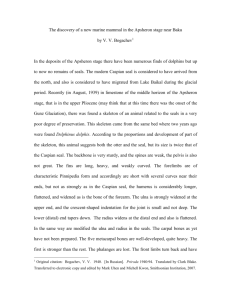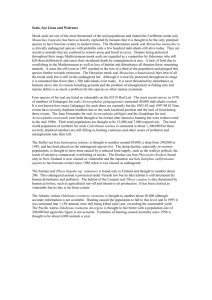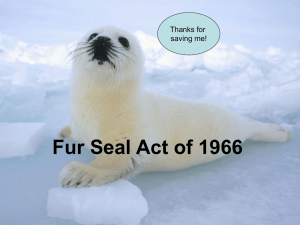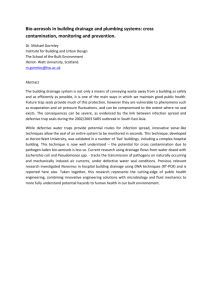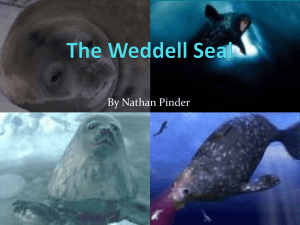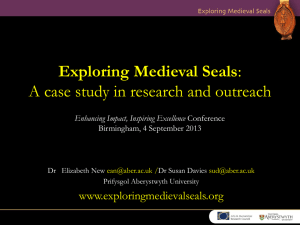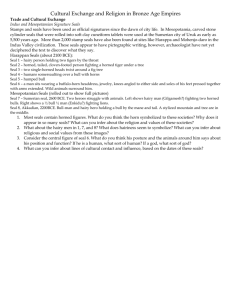Word
advertisement
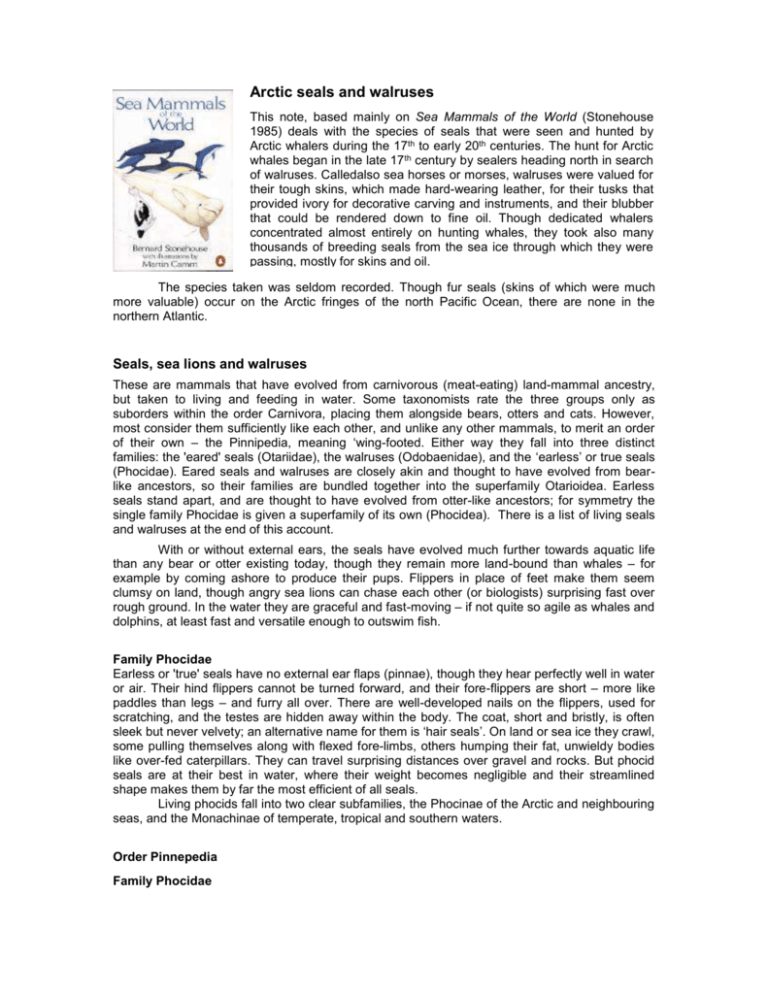
Arctic seals and walruses This note, based mainly on Sea Mammals of the World (Stonehouse 1985) deals with the species of seals that were seen and hunted by Arctic whalers during the 17th to early 20th centuries. The hunt for Arctic whales began in the late 17th century by sealers heading north in search of walruses. Calledalso sea horses or morses, walruses were valued for their tough skins, which made hard-wearing leather, for their tusks that provided ivory for decorative carving and instruments, and their blubber that could be rendered down to fine oil. Though dedicated whalers concentrated almost entirely on hunting whales, they took also many thousands of breeding seals from the sea ice through which they were passing, mostly for skins and oil. The species taken was seldom recorded. Though fur seals (skins of which were much more valuable) occur on the Arctic fringes of the north Pacific Ocean, there are none in the northern Atlantic. Seals, sea lions and walruses These are mammals that have evolved from carnivorous (meat-eating) land-mammal ancestry, but taken to living and feeding in water. Some taxonomists rate the three groups only as suborders within the order Carnivora, placing them alongside bears, otters and cats. However, most consider them sufficiently like each other, and unlike any other mammals, to merit an order of their own – the Pinnipedia, meaning ‘wing-footed. Either way they fall into three distinct families: the 'eared' seals (Otariidae), the walruses (Odobaenidae), and the ‘earless’ or true seals (Phocidae). Eared seals and walruses are closely akin and thought to have evolved from bearlike ancestors, so their families are bundled together into the superfamily Otarioidea. Earless seals stand apart, and are thought to have evolved from otter-like ancestors; for symmetry the single family Phocidae is given a superfamily of its own (Phocidea). There is a list of living seals and walruses at the end of this account. With or without external ears, the seals have evolved much further towards aquatic life than any bear or otter existing today, though they remain more land-bound than whales – for example by coming ashore to produce their pups. Flippers in place of feet make them seem clumsy on land, though angry sea lions can chase each other (or biologists) surprising fast over rough ground. In the water they are graceful and fast-moving – if not quite so agile as whales and dolphins, at least fast and versatile enough to outswim fish. Family Phocidae Earless or 'true' seals have no external ear flaps (pinnae), though they hear perfectly well in water or air. Their hind flippers cannot be turned forward, and their fore-flippers are short – more like paddles than legs – and furry all over. There are well-developed nails on the flippers, used for scratching, and the testes are hidden away within the body. The coat, short and bristly, is often sleek but never velvety; an alternative name for them is ‘hair seals’. On land or sea ice they crawl, some pulling themselves along with flexed fore-limbs, others humping their fat, unwieldy bodies like over-fed caterpillars. They can travel surprising distances over gravel and rocks. But phocid seals are at their best in water, where their weight becomes negligible and their streamlined shape makes them by far the most efficient of all seals. Living phocids fall into two clear subfamilies, the Phocinae of the Arctic and neighbouring seas, and the Monachinae of temperate, tropical and southern waters. Order Pinnepedia Family Phocidae Subfamily Phocinae Phoca vitulina (5 races) Pusa hispida (6 races) Pusa sibirica Pusa caspica Halichoerus grypus Histriophoca fasciata Pagophilus groenlandicus Erignathus barbatus (2 races) Cystophora cristata Harbour Seal Ringed Seal Baikal Seal Caspian Seal Grey Seal Ribbon Seal Harp Seal Bearded Seal Hooded Seal Subfamily Monachinae Monachus monachus Monachus tropicalis Monachus schauinslandi Ommatophoca rossi Lobodon carcinophagus Hydrurga leptonyx Leptonychotes weddelli Mirounga leonina Mirounga angustirostris Mediterranean Monk Seal Caribbean Monk Seal Hawaiian Monk Seal Ross Seal Crabeater Seal Leopard Seal Weddell Seal Southern Elephant Seal Northern Elephant Seal Phocine seals characteristically have three incisors on either side of the upper jaw. The digits (toes) of the hind flippers are almost equal in length and carry prominent claws; those of the front flippers (fingers) can be clenched to pull the animal forward over snow or ice. The pups have a white natal coat. All nine species live in the north. Two species, Ringed and Bearded Seals, are circumpolar, breeding far north on the pack-ice. Three species (Harp, Hooded and Ribbon seals) breed mainly along the edge of the pack-ice, dispersing northward as it retreats in summer. Grey and Harbour seals keep mainly to cool temperate waters, though some are found also on the Arctic fringes. Baikal and Caspian seals are restricted entirely to their own inland waters. Monachine seals typically have two incisors on either side of the upper jaw and two below: elephant seals are exceptional with only one below. On the hind flippers the two outer digits are notably longer than the middle three, and the claws are small. The pups have grey, brown or black coats. Of the nine living species, three species of monk seals live northernhemisphere waters of the Mediterranean Sea, nearby Atlantic islands, the Caribbean Sea and Hawaii. Northern Elephant seals too are a warm-water species, living off the coasts of Mexico and California. The rest of the monachines are seals of cold or icy southern waters. Northern seals that were taken by whalers Harbour or Common Seal Phoca vitulina Linnaeus 1758 SIZE. Males: nose-to-tail length 1.6-1.9 m, weight to 120 kg. Females average 10 % smaller. APPEARANCE. A small, fat, round-headed seal. Colour variable; leaden-grey with dark spots, darker grey with pale spots, sandy or dark brown; sometimes slightly paler underneath. Pups have, first, a soft white fur, normally shed before or at birth, followed by blue-grey fur, paler on the underparts, which lasts almost a year until the first moult. Teeth: upper 3 1 2 3, lower 3 1 2 3; cheek teeth strongly cusped, set slightly obliquely in jaw. RANGE. Five geographical races are identified: (i) P.v. vitulina, Europe from northern Spain to North Cape and Iceland; (ii) P.v. concolor, North America from Maine to Ellesmere Islands, western and southern Greenland; (iii) P.v. mellonae, a small stock in freshwater lakes east of Hudson Bay; (iv) P.v. richardi, eastern Pacific and Arctic Oceans from southern California to the north coast of Alaska, including the Aleutian Islands; (v) P.v. largha, western Pacific Ocean from Korea and southern Japan to Bering Strait. Harbour Seals are small, shy, coastal and estuarine seals, found mainly in sandy bays, sea lochs and shallows - sometimes on shelving rocky coasts, seldom on steep ones. Sociable but not colonial, they rarely come ashore. Though occasionally found resting on beaches, their favourite haunts for hauling out are sandbanks and rocky ledges exposed at low tide. Fish eaters, they often fall foul of inshore fishermen, with whom they compete. Breeding groups gather in sheltered waters from spring to late summer, dates varying with race and locality. Courtship is boisterous, displaying males leaping like salmon from the water. Embryos implant after a delay often weeks. Pups of P.v. largha are born mostly on icefloes between February and April, retaining their white downy coats. Those of other races are born in May and June, on sandbanks and rock shelves at low tide. The pups are large and wellformed, and able to swim alongside their mothers only hours later. They reach independence in five to six weeks, having trebled their birth weight in that period. Tens of thousands - mostly yearlings - are taken annually for their skins. World population of Common Seals probably approaches half a million. Ringed Seal Pusa hispida (Schreber 1775) SIZE. Male: nose-to-tail length 1.2-1.8 m; weight to 130 kg. Sexes similar, males on average slightly larger. APPEARANCE. Small, fat, round-headed: colour dull grey-brown with large dark spots (often white-ringed), merging to blotches and stripes on the back; underside paler, speckled. Fur coarse, stiff; prominent yellow-brown whiskers. Pups born white, acquiring grey coat at one month. Teeth: upper 3 1 4 1, lower 2 1 4 1; cheek teeth conical with two small cusps. RANGE. Circumpolar Arctic, generally among pack-ice. Six geographical races: (i) P. h. hispida, polar basin, Greenland, northern Iceland, Labrador, Canadian archipelago, northern Scandinavia; (ii) P.h. krascheninikavi, northern Bering Sea and eastern Kamchatka, Sakhalin and northern Japan; (iv) P.h. botnica, Baltic Sea, Gulf of Bothnia and Finland; (v) P.h. saimensis. Lake Saimaa, Finland; (vi) P.h. ladogensis, Lake Ladoga, Finland. The last two may be variants of P.h. botnica. Non-migratory; stragglers have been recorded off northern Britain. This is a seal of inshore ice, probably the commonest and certainly the most widespread Arctic species. It feeds on the larger crustaceans of the plankton and small fish caught in shallow water at depths down to a hundred metres. Sociable but not colonial, Ringed Seals gather to mate in April, where pups are still being suckled on the nursery ice. The embryos implant in August, and the pups are born seven to eight months later in March and April, usually in snow caverns or sheltered hollows of the ice-field. Though safe from casual predators, they may be dug out by Arctic Foxes or Polar Bears. Adults maintain winter breathing holes in the ice, where they are vulnerable both to Polar Bears and to Eskimo harpoons. World population is estimated at two to six million. Many thousands - mostly pups - are killed each year for the fur trade. Grey Seal Halichoerus grypus (Fabricius 1791) SIZE. Males: nose-to-tail length to 3.om, weight 250-280 kg. Females 10-15% smaller. APPEARANCE. Large mottled seals; in males the mottling is dark grey on a fawn background, in females pale grey on a darker background, with relatively pale face and belly. The convex 'Roman' nose is distinctive. Pups have a white woolly coat for three weeks, then blue-grey fur. Teeth: upper and lower 3 1 4 1. RANGE. North Atlantic, in three discrete but little-differentiated populations: (i) Britain, Norway, White Sea, Iceland and Faeroe Islands; (ii) Baltic Sea; (iii) Gulf of St Lawrence, Newfoundland, and the neighbouring waters. These are seals of rocky shores and troubled waters, found typically among islands and reefs of exposed coasts. They are the characteristic seals of Britain's northern and western isles, though common too on the sandbanks and beaches of the North Sea. Britain's stocks of Grey Seals, now estimated at over thirty-five thousand and probably growing, include half to two thirds of the world's population. Mainly fish eaters, Grey Seals feed at all depths down to a hundred metres or more, diving for spells of up to twenty minutes. Their diet includes flatfish, molluscs and other creatures of the sea bed, and a proportion of commercial fish that makes many fishermen their enemies. Sociable and colonial, they haul out in the autumn in large, untidy breeding groups, usually on remote islands. In the eastern Atlantic most pups are born between September and December, in the Gulf of St Lawrence from late January to March, though breeding may occur in any month of the year. Bulls fight in rivalry over territories as the first pups of the season appear, and the cows are ready for mating even before their offspring of the year are weaned. When breeding is over both adults and young return to the sea independently, older seals hauling out again in late spring to complete their moult. Harp Seal Pagophilus groenlandicus (Erxleben 1777) SIZE. Males: length nose to tail 1.8 m; weight to 180 kg. Females slightly smaller. APPEARANCE. A small- to medium-sized piebald seal. In males the fur is white or strawcoloured, the face black or dark brown, and a ring, 'harp', or horseshoe of coalescing dark spots decorates the back. Females and young are grey, usually with a less distinctive pattern of dark spots and a paler muzzle; older females, like the one in the illustration, have darker head and flank patches similar to those of the male. Pups are born in white woolly fur, which is replaced at three to four months with fine grey fur that grows progressively more spotted throughout their first year; thereafter the markings tend to increase and darken with age. Teeth: upper 3 1 4 1, lower 2 1 4 1, small, well spaced apart. RANGE. Arctic and North Atlantic, breeding on deep-water ice-fields centred in the southern Barents Sea, the Greenland Sea, the Gulf of St Lawrence, and off Labrador. Migratory over the Atlantic north of 6o°N and neighbouring sections of the Arctic Ocean, and an occasional visitor to Britain and Western Europe. These are seals of open water and pack-ice, seldom found ashore or close to land. Pelagic feeders, they browse throughout summer in the rich surface waters of the high Arctic and the subArctic, taking plankton and schooling fish. As the ice forms in late autumn they head south towards their traditional breeding grounds, hauling out in the middle of large fields of hummocky pack-ice, where they are protected from wave action and from the attentions of Killer Whales. Pups are born off eastern Greenland in late March, elsewhere in late February or March. Males join the colonies as the pups are born; mating occurs two to three weeks later as the pups shed their white coats and enter the sea for the first time. With a huge population, possibly totalling five million, this is the most heavily hunted of all the world's seals. Some hundreds of thousands of pups and young animals are taken by commercial hunters each year, mostly for their fur. Local stocks are reduced from time to time, but the species as a whole does not appear to be endangered; nor is it likely to be while the main centres of breeding are protected by bastions of fast ice which small vessels cannot enter. Public protest based on the cruelty of the annual slaughter has so far had little effect. Pups and juveniles will no doubt continue to be killed so long as there remains a flourishing market for their skins. Bearded Seal Erignathus barbatus (Erxleben 1777) SIZE. Males: nose-to-tail length 2.5-3.0 m; weight to 400 kg. Females slightly smaller. APPEARANCE. Large seals with plain fur, only weakly mottled or spotted; cinnamon-brown on back, greyish or yellow flanks, underside and flippers. Fore-flippers square-cut, with strong black claws. Strikingly bushy moustache of yellow whiskers, long and curved; heavy lower jaw. Four mammae. Teeth: upper and lower 3 1 4 1, molars often worn down to stumps. RANGE. Circumpolar Arctic. Two races are distinguished: (i) E. b. barbatus, Arctic coast from Laptev Sea westward to northern Scandinavia; Greenland, northeastern Canada to Hudson Bay and Gulf of St Lawrence; (ii) E. b. nautica, Arctic coast of north-east Asia, Kamchatka, Sea of Okhotsk, Sakhalin Island, Kurile Islands, northern Bering Sea, Arctic coasts of Alaska and Canada. Among the largest of the northern seals, the Bearded Seal makes its home on moving inshore ice, in shallow coastal waters where the sea bed is rich in food. Like its distant cousin the Walrus, this seal is a bottom feeder, sometimes hunting at depths of a hundred metres or more. The 'beard' - more accurately a curly moustache - is highly sensory, presumably used for detecting food on a muddy sea bed. The worn teeth, typical of most adults, testify to a diet that includes many hard-shelled crustaceans and molluscs. Rather solitary animals, Bearded Seals lie widely scattered across the sea ice in April and May when the pups are born. Over a metre long at birth, the grey-coated pups seem to spend several more weeks with their mothers than those of other Arctic species, so mature females usually mate only in alternate years. World population is estimated at a hundred to a hundred and fifty thousand; too widely dispersed to attract the commercial hunters, they are of interest mainly to Eskimos and other local hunters, who value their tough hides for traces, bindings and boot leather. Hooded Seal Cystophora cristata (Erxleben 1777) SIZE. Males: nose-to-tail length 3-3.5 m, weighing to 400 kg or more; females are slightly smaller. APPEARANCE. Large silver-grey seals, splashed irregularly with dark grey or black spots. Face dark; in adult males the upper surface of the nose and forehead is inflatable, producing a bulbous profile - possibly a threat-signal for rivals. Claws unusually prominent, especially on the foreflippers. Teeth: upper 2 1 5, lower 1 1 5; cheek teeth are widely spaced pegs. RANGE. North Atlantic and Arctic Ocean sea ice, from Newfoundland and Baffin Island in the west to Spitzbergen, Jan Mayen and Iceland in the east, usually on stable pack-ice in offshore waters. Vagrants have been recorded from as far south as Florida, Britain and the Bay of Biscay. There are two main breeding centres - a small one between Labrador and Greenland, and a larger one north of Jan Mayen; smaller groups breed in the Gulf of St Lawrence and Davis Strait. Seldom found inshore, Hooded Seals live well out to sea, feeding on plankton and fish mostly in surface waters, and hauling out on to the floes to rest. They gather in huge groups on the stable winter ice of the breeding areas in March and April, pairing off as the silvery-grey pups are born. Mating occurs two to three weeks after birth, and the family groups disperse some three weeks later. Throughout summer many Hooded Seals moult on the heavy pack-ice between Greenland and Iceland; in winter they are spread thinly wherever there is open water for them to feed. The large breeding concentrations are subject to controlled hunting under international agreement; tens of thousands of pups are taken each year for their fleecy coats, and as many adults for their oil and leather. The total population, estimated mainly from aerial counts, probably exceeds 500,000. Walruses Walruses are large, heavily-built seals in a family – Odobenidae – of their own. They have no external ear pinna and a rough, scaly skin with no fur. Their most striking features are their massive bulk, bristling moustaches, and the huge canine tusks that they use for raking the sea bed in search of clams, their favourite food. There is only one species, circumpolar in Arctic and sub-Arctic waters. Walrus Odobenus rosmarus (Linnaeus 1758) SIZE. Males: nose-to-tail length 3-3.7 m, weight up to 1.5 tonnes. Females slightly shorter and 30-40 per cent lighter in weight. APPEARANCE. Like huge, overgrown sea lions, Walruses are the otariid equivalent of elephant seals, and second only to them in size. Thick, almost hairless brown hide (wrinkled even in newborn pups); broad, blunt head with tiny eyes, and external ears barely visible. The upper lips, enormously padded, bristle like pincushions with sensory hairs. Teeth: upper 1 1 3 0, lower 0 1 3 0; the upper canines form prominent tusks in both sexes, the cheek teeth are flattened and reduced. RANGE. There are two very similar geographical races: (i) O. r. rosmarus, the Atlantic Walrus, found from northern and eastern Hudson Bay to Devon and Ellesmere Islands, Baffin Island and western Greenland, with smaller populations off northern Iceland and in the Kara and Barents Seas north beyond Franz Josef Land; (ii) O. r. divergens, the Pacific Walrus of the northern Bering, Chukchi, East Siberian and Laptev Seas; it is found mainly on inshore sea ice over shallow water. Vagrants have wandered as far south as Britain and Japan. With their unwieldy bulk, wrinkles, piggy eyes and permanently aggrieved expressions, Walruses are perhaps the least beautiful of all the seals, though like others they acquire grace on entering the water. Highly gregarious, they gather in clubs on beaches and ice-floes, and swim in large herds during their seasonal movements as the sea ice advances and retreats. They feed on the sea bed, using their massive ivory tusks (up to a metre long in large males) to stir the mud in search of cockles, clams and molluscs; the sensitive bristles are probably important in foodfinding, and the crushing teeth break open the shells. Walruses also take fish, and occasionally smaller seals. They gather on the fast ice in spring; the pups are born in April and May, and mating occurs soon after. Over 1 metre long at birth, and weighing more than 40 kg, the pups grow slowly, quadrupling their birth weight during the first year. Gestation and lactation each last about twelve months, and females probably breed every third or fourth year. The two forms of Walrus are very similar; Pacific stocks have slightly broader faces and larger tusks. Hunting for oil, ivory and skins over two or three centuries has severely reduced them, and some local stocks (for example, those of the Laptev Sea) are small enough to cause concern. However, both subspecies are now largely protected, and total world population is probably between 100,000 and 150,000.
